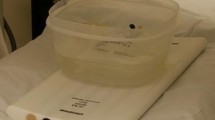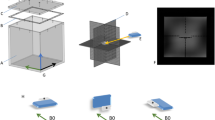Abstract
Biometals cause signal loss and susceptibility artefacts in the surrounding tissue, resulting in deterioration in magnetic resonance (MR) images. This metal-artefact effect may lead to interpretation challenges for MR images. Therefore, artefact reduction is required to obtain higher-quality images. This paper aims to analyse the impact of imaging sequence and metallic biomaterial design on MR image artefacts. In this respect, implant specimens were designed in thin, thick, and pointed forms and manufactured using 316LVM, 316L, CoCr-alloy, and Ti-alloy, which are commonly utilized materials in the biomaterials field. Specimens were placed in a phantom that simulates average human anatomy separately and scanned in a 1.5 T MRI under four imaging conditions: “Axial-T1-Gradient-Echo (GRE)”, “Sagittal-T1-GRE”, “Axial-T2-Spin-Echo (SE)” and “Sagittal-T2-SE”. Images were analysed regarding image artefact amount. The lower magnetic susceptibility of Ti-alloy specimens caused 84.76% less deterioration than 316LVM specimens in the MR images with the mean image artefact-to-specimen size ratio. Thinner implant designs provided better performance regarding the metal artefact by reducing the artefact-to-specimen size ratio. T2SE decreased the image artefact by 44.7% for 316LVM and 54.6% for Ti-Alloy specimens and provided better image quality than T1GRE for clinical interpretation. This study reveals that image artefacts directly depend on material content, implant volume, geometry, and imaging sequence selection. The minor artefact effect of T2SE provides more accurate MR images than T1GRE regarding the interpretation of the images of the patients with biometals. The higher magnetic susceptibility of biometals causes more deterioration of the images.








Similar content being viewed by others
References
Brown RW, Cheng Y-CN, Haacke EM, Thompson MR, Venkatesan R (2014) Magnetic resonance imaging: physical principles and sequence design. Wiley, Hoboken
Liang Z-P, Lauterbur PC (2000) Principles of magnetic resonance imaging: a signal processing perspective [Book Review]. Wiley-IEEE Press, New York
Lakshmeeha T, Ajith Kumar KS, Vishanth SC, Kiran SC (2019) Study of correlation between clinical findings, radiological and intra operative findings in lumbar disc prolapse. Int J Orthop Sci 5:65–68. https://doi.org/10.22271/ortho.2019.v5.i3b.1509
Nacher PJ, Kumaragamage S, Tastevin G, Bidinosti CP (2020) A fast MOSFET rf switch for low-field NMR and MRI. J Magn Reson. https://doi.org/10.1016/j.jmr.2019.106638
Vinding MS, Skyum B, Sangill R, Lund TE (2019) Ultrafast (milliseconds), multidimensional RF pulse design with deep learning. Magn Reson Med. https://doi.org/10.1002/mrm.27740
Galley J, Sutter R, Stern C, Filli L, Rahm S, Pfirrmann CWA (2020) Diagnosis of periprosthetic hip joint infection using MRI with metal artifact reduction at 1.5 T. Radiology. https://doi.org/10.1148/radiol.2020191901
Wimmer W, Hakim A, Kiefer C, Pastore-Wapp M, Anschuetz L, Caversaccio MD, Wagner F (2019) MRI metal artifact reduction sequence for auditory implants: first results with a transcutaneous bone conduction implant. Audiol Neurotol. https://doi.org/10.1159/000500513
Hargreaves BA, Worters PW, Pauly KB, Pauly JM, Koch KM, Gold GE (2011) Metal-induced artifacts in MRI. Am J Roentgenol. https://doi.org/10.2214/AJR.11.7364
Sinclair AG, Scoffings DJ (2010) Imaging of the post-operative cranium. Radiographics. https://doi.org/10.1148/rg.302095115
Carter LN, Addison O, Naji N, Seres P, Wilman AH, Shepherd DET, Grover L, Cox S (2020) Reducing MRI susceptibility artefacts in implants using additively manufactured porous Ti–6Al–4V structures. Acta Biomater. https://doi.org/10.1016/j.actbio.2020.02.038
Smith MR, Artz NS, Wiens C, Hernando D, Reeder SB (2015) Characterizing the limits of MRI near metallic prostheses. Magn Reson Med 74:1564–1573. https://doi.org/10.1002/mrm.25540
Daga P, Pendse T, Modat M, White M, Mancini L, Winston GP, McEvoy AW, Thornton J, Yousry T, Drobnjak I, Duncan JS, Ourselin S (2014) Susceptibility artefact correction using dynamic graph cuts: application to neurosurgery. Med Image Anal 18:1132–1142. https://doi.org/10.1016/j.media.2014.06.008
Sundermann B, Billebaut B, Bauer J, Iacoban CG, Alykova O, Schülke C, Gerdes M, Kugel H, Neduvakkattu S, Bösenberg H, Mathys C (2022) Practical aspects of novel MRI techniques in neuroradiology: part 1–3D acquisitions, dixon techniques and artefact reduction. RöFo. https://doi.org/10.1055/a-1800-8692
Dewey RS, Dineen RA, Clemence M, Dick O, Bowtell R, Kitterick PT (2021) Parametric assessment of the effect of cochlear implant positioning on brain MRI artefacts at 3T. Otol Neurotol. https://doi.org/10.1097/MAO.0000000000003281
Kim JH, Ahn SJ, Park M, Kim YB, Joo B, Lee W, Suh SH (2021) Follow-up imaging of clipped intracranial aneurysms with 3-T MRI: comparison between 3D time-of-flight MR angiography and pointwise encoding time reduction with radial acquisition subtraction-based MR angiography. J Neurosurg. https://doi.org/10.3171/2021.7.jns211197
Espiritu J, Berangi M, Yiannakou C, Silva E, Francischello R, Kuehne A, Niendorf T, Könneker S, Willumeit-Römer R, Seitz JM (2022) Evaluating metallic artefact of biodegradable magnesium-based implants in magnetic resonance imaging. Bioact Mater. https://doi.org/10.1016/j.bioactmat.2021.11.035
Akçakaya M, Tang M, Nezafat R (2019) Cardiac magnetic resonance imaging. In: Kwong RY, Jerosch-Herold M, Heydari B (eds) Cardiovascular magnetic resonance imaging, 2nd edn. Springer, New York, pp 1–16
Sands MJ, Levitin A (2004) Basics of magnetic resonance imaging. Semin Vasc Surg 17:66–82
Fong W (2005) Handbook of MRI pulse sequences. Med Phys 32:1452. https://doi.org/10.1118/1.1904597
Deichmann R, Nöth U, Weiskopf N (2010) The basics of functional magnetic resonance imaging. In: EEG-fMRI: physiological basis, technique, and applications Springer, Berlin, pp 39–62
Wolbarst A (2015) TU-EF-BRA-01: NMR and proton density MRI of the 1D patient. Med Phys 42: 3618–3619. https://doi.org/10.1118/1.4925678
Schenck JF (2005) Physical interactions of static magnetic fields with living tissues. Prog Biophys Mol Biol 87:185–204. https://doi.org/10.1016/j.pbiomolbio.2004.08.009
Wolbarst A (2015) TU-EF-BRA-01: NMR and proton density MRI of the 1D patient. Med Phys. https://doi.org/10.1118/1.4925678
Khajehim M, Christen T, Tam F, Graham SJ (2021) Streamlined magnetic resonance fingerprinting: fast whole-brain coverage with deep-learning based parameter estimation. NeuroImage. https://doi.org/10.1016/j.neuroimage.2021.118237
Khajehim M, Christen T, Chen JJ (2019) Magnetic resonance fingerprinting with combined gradient- and spin-echo echo-planar imaging: simultaneous estimation of T1, T2 and T2* with integrated-B1 correction. bioRxiv. https://doi.org/10.1101/604546
Jaubert O, Cruz G, Bustin A, Hajhosseiny R, Nazir S, Schneider T, Koken P, Doneva M, Rueckert D, Masci PG, Botnar RM, Prieto C (2021) T1, T2, and fat fraction cardiac MR fingerprinting: preliminary clinical evaluation. J Magn Reson Imaging. https://doi.org/10.1002/jmri.27415
Sharma HA, Lagopoulos J (2010) MRI physics: pulse sequences. Acta Neuropsychiatr 22:90–92
Eckstein F, Burstein D, Link TM (2006) Quantitative MRI of cartilage and bone: degenerative changes in osteoarthritis. NMR Biomed 19:822–854
Deka B, Datta S (2019) Introduction to compressed sensing magnetic resonance imaging. In: Compressed sensing magnetic resonance image reconstruction algorithms, Springer, Singapore, pp 1–22
Weishaupt D, Kochli VD, Marincek B, Kim EE (2007) How does MRI work? An introduction to the physics and function of magnetic resonance imaging. J Nucl Med. https://doi.org/10.2967/jnumed.107.045104
Chen F, Taviani V, Malkiel I, Cheng JY, Tamir JI, Shaikh J, Chang ST, Hardy CJ, Pauly JM, Vasanawala SS (2018) Variable-density single-shot fast spin-echo MRI with deep learning reconstruction by using variational networks. Radiology. https://doi.org/10.1148/radiol.2018180445
Loening AM, Saranathan M, Ruangwattanapaisarn N, Litwiller DV, Shimakawa A, Vasanawala SS (2015) Increased speed and image quality in single-shot fast spin echo imaging via variable refocusing flip angles. J Magn Reson Imaging. https://doi.org/10.1002/jmri.24941
Kadamangudi S, Reutens D, Sood S, Vegh V (2018) Signal compartments in ultra-high field multi-echo gradient echo MRI reflect underlying tissue microstructure in the brain. NeuroImage. https://doi.org/10.1016/j.neuroimage.2018.05.061
Markl M, Leupold J (2012) Gradient echo imaging. J Magn Reson Imaging 35:1274–1289. https://doi.org/10.1002/jmri.23638
Virtanen H, Keshvari J, Lappalainen R (2006) Interaction of radio frequency electromagnetic fields and passive metallic implants—a brief review. Bioelectromagnetics 27:431–439
Istanbullu OB, Akdoǧan G (2016) Evaluation of MRI compatibility and safety risks for biomaterials. In: 2015 medical technologies national conference, TIPTEKNO 2015
Ratner BD, Hoffman AS, Schoen FJ, Lemons JE (2013) Biomaterials science: an evolving, multidisciplinary endeavor, 3rd edn. Elsevier, Amsterdam
Agten CA, Del Grande F, Fucentese SF, Blatter S, Pfirrmann CWA, Sutter R (2015) Unicompartmental knee arthroplasty MRI: impact of slice-encoding for metal artefact correction MRI on image quality, findings and therapy decision. Eur Radiol 25:2184–2193. https://doi.org/10.1007/s00330-015-3596-4
Park J, Lakes RS (2007) Biomaterials: an introduction, 3rd edn. Springer, New York
Poh PG, Liew C, Yeo C, Chong LR, Tan A, Poh A (2017) Cardiovascular implantable electronic devices: a review of the dangers and difficulties in MR scanning and attempts to improve safety. Insights Imaging 8:405–418
ASTM (2006) F2052 standard test method for measurement of magnetically induced displacement force. ASTM, West Conshohocken
Xuan X (2019) Recent advances in continuous-flow particle manipulations using magnetic fluids. Micromachines 10:744
Schenck JF (2000) Safety of strong, static magnetic fields. J Magn Reson Imaging 12:2–19.
Ozawa E, Honda E, Parakonthun KN, Ohmori H, Shimazaki K, Kurabayashi T, Ono T (2018) Influence of orthodontic appliance-derived artifacts on 3-T MRI movies. Prog Orthod. https://doi.org/10.1186/s40510-018-0204-6
Krupa K, Bekiesińska-Figatowska M (2015) Artifacts in magnetic resonance imaging. Pol J Radiol. https://doi.org/10.12659/PJR.892628
Choi JS, Kim S, Yoo D, Shin TH, Kim H, Gomes MD, Kim SH, Pines A, Cheon J (2017) Distance-dependent magnetic resonance tuning as a versatile MRI sensing platform for biological targets. Nat Mater 16(5):537–542
Lee YH, Hahn S, Kim E, Suh J-S (2016) Fat-suppressed MR imaging of the spine for metal artifact reduction at 3 T: comparison of STIR and slice encoding for metal artifact correction fat-suppressed T2-weighted images. Magn Reson Med Sci XX:1–8. https://doi.org/10.2463/mrms.mp.2015-0055
Greenbaum B, Barnes FS (2018) Bioengineering and biophysical aspects of electromagnetic fields. CRC Press, Boca Raton
ASTM (2015) F2119 standard test method for evaluation of MR image artifacts from passive implants. ASTM, West Conshohocken
Wooldridge J, Arduino A, Zilberti L, Zanovello U, Chiampi M, Clementi V, Bottauscio O (2021) Gradient coil and radiofrequency induced heating of orthopaedic implants in MRI: influencing factors. Phys Med Biol. https://doi.org/10.1088/1361-6560/ac3eab
Golestanirad L, Kirsch J, Bonmassar G, Downs S, Elahi B, Martin A, Iacono MI, Angelone LM, Keil B, Wald LL, Pilitsis J (2019) RF-induced heating in tissue near bilateral DBS implants during MRI at 1.5 T and 3 T: the role of surgical lead management. NeuroImage. https://doi.org/10.1016/j.neuroimage.2018.09.034
ASTM (2020) F2182-19e2 standard test method for measurement of radiofrequency induced heating near passive implants during magnetic resonance imaging. Annu B ASTM Stand 1301:1–11. https://doi.org/10.1520/F2052-06E01
Acknowledgements
The authors would like to thank Onur Medikal Ltd. Sti., Aysam Orthopaedics & Medical Devices, K.GUMUS, and I. KIZILOZ for their support.
This study was supported by funds from the Erciyes University Scientific Research Projects Unit (Grant number FYL-2015-6051).
Funding
This study was supported by funds from the Erciyes University Scientific Research Projects Unit (Grant Number FYL-2015-6051).
Author information
Authors and Affiliations
Corresponding author
Ethics declarations
Conflict of interest
The authors declare that they have no conflicts of interest related to this work.
Ethical approval
for animal experiments was obtained from the Animal Experiments Local Ethics Committee of Erciyes University in accordance with the National Research Council’s Guide for the Care and Use of Laboratory Animals (Decree no. 19/078).
Additional information
Publisher’s Note
Springer Nature remains neutral with regard to jurisdictional claims in published maps and institutional affiliations.
Rights and permissions
Springer Nature or its licensor (e.g. a society or other partner) holds exclusive rights to this article under a publishing agreement with the author(s) or other rightsholder(s); author self-archiving of the accepted manuscript version of this article is solely governed by the terms of such publishing agreement and applicable law.
About this article
Cite this article
Akdogan, G., Istanbullu, O. Analysing the effects of metallic biomaterial design and imaging sequences on MRI interpretation challenges due to image artefacts. Phys Eng Sci Med 45, 1163–1174 (2022). https://doi.org/10.1007/s13246-022-01183-7
Received:
Accepted:
Published:
Issue Date:
DOI: https://doi.org/10.1007/s13246-022-01183-7




